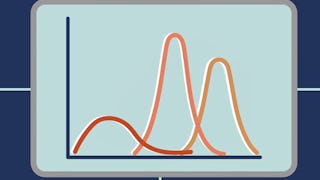Ce cours vous initie à l'échantillonnage et à l'exploration des données, ainsi qu'à la théorie de base des probabilités et à la règle de Bayes. Vous examinerez différents types de méthodes d'échantillonnage et discuterez de l'impact de ces méthodes sur la portée de l'inférence. Diverses techniques d'analyse exploratoire des données seront abordées, y compris les statistiques numériques sommaires et la visualisation des données de base. Vous serez guidé dans l'installation et l'utilisation de R et de RStudio (logiciel statistique gratuit), et vous utiliserez ce logiciel pour des exercices en laboratoire et un projet final. Les concepts et les techniques de ce cours serviront de base aux cours d'inférence et de modélisation de la Specializations.

Cultivez votre carrière grâce à des programmes dirigés par des experts, des certificats prêts à l'emploi et des moyens d'évoluer sur 10 000 . Le tout pour 25 $US/mois, facturé annuellement. Économisez


Introduction aux probabilités et aux données avec R
Ce cours fait partie de Spécialisation Analyse de données avec R

Instructeur : Mine Çetinkaya-Rundel
295 183 déjà inscrits
Inclus avec 
(5,744 avis)
Compétences que vous acquerrez
- Catégorie : Analyse des Données
- Catégorie : Probabilités et statistiques
- Catégorie : Statistiques Générales
- Catégorie : Programmation Statistique
- Catégorie : Programmation Informatique
Détails à connaître

Ajouter à votre profil LinkedIn
11 devoirs
Découvrez comment les employés des entreprises prestigieuses maîtrisent des compétences recherchées

Élaborez votre expertise du sujet
- Apprenez de nouveaux concepts auprès d'experts du secteur
- Acquérez une compréhension de base d'un sujet ou d'un outil
- Développez des compétences professionnelles avec des projets pratiques
- Obtenez un certificat professionnel partageable


Obtenez un certificat professionnel
Ajoutez cette qualification à votre profil LinkedIn ou à votre CV
Partagez-le sur les réseaux sociaux et dans votre évaluation de performance

Il y a 8 modules dans ce cours
Ce cours vous initie à l'échantillonnage et à l'exploration des données, ainsi qu'à la théorie de base des probabilités. Vous examinerez différents types de méthodes d'échantillonnage et discuterez de l'impact de ces méthodes sur l'utilité d'une analyse de données. Chaque leçon est accompagnée d'un ensemble d'objectifs d'apprentissage qui seront couverts par une série de courtes vidéos. Des lectures complémentaires et des problèmes pratiques seront également suggérés à partir de OpenIntro Statistics, 3rd Edition, https://leanpub.com/openintro-statistics/, (un manuel d'introduction aux statistiques en ligne gratuit, que j'ai co-écrit). Il y aura des quiz hebdomadaires conçus pour évaluer votre apprentissage et votre maîtrise du matériel couvert cette semaine-là dans les vidéos. En outre, chaque semaine, vous aurez un travail de laboratoire, dans lequel vous utiliserez R pour appliquer ce que vous apprenez à des données réelles. Il y aura également un projet d'analyse de données conçu pour vous permettre de répondre à des questions de recherche de votre choix. Comme il s'agit d'un cours Coursera, vous êtes invité à participer autant ou aussi peu que vous le souhaitez, bien que j'espère que vous commencerez par participer pleinement. L'un des aspects les plus gratifiants d'un cours Coursera est la participation aux discussions du forum sur les supports de cours. N'hésitez pas à profiter des commentaires et des idées des autres étudiants et à apporter votre propre point de vue lorsque vous le jugez utile. Vous pouvez également consulter la page de ressources (https://www.coursera.org/learn/probability-intro/resources/crMc4) qui répertorie les ressources utiles pour ce cours. Merci de rejoindre la communauté de l'Introduction aux probabilités et aux données ! Dites bonjour dans les forums de discussion. Nous nous réjouissons de votre participation à ce cours.
Inclus
1 vidéo1 lecture
Bienvenue dans le cours Introduction aux probabilités et aux données ! J'espère que vous êtes aussi enthousiaste que moi à l'idée de suivre ce cours ! Au cours des cinq prochaines semaines, nous apprendrons à concevoir des études, à explorer des données à l'aide de résumés numériques et de visualisations, et nous nous familiariserons avec les règles de probabilité et les distributions de probabilité couramment utilisées. Si vous avez des questions, n'hésitez pas à les poster sur le forum de ce module (https://www.coursera.org/learn/probability-intro/module/rQ9Al/discussions?sort=lastActivityAtDesc&page=1) et à en discuter avec vos pairs ! Pour commencer, consultez les objectifs d'apprentissage (https://www.coursera.org/learn/probability-intro/supplement/rooeY/lesson-learning-objectives) de la Leçon 1 de ce module.
Inclus
6 vidéos2 lectures2 devoirs
Pour réaliser ce travail, vous utiliserez R et RStudio installés sur votre ordinateur local ou via RStudio Cloud.
Inclus
2 lectures1 devoir
Bienvenue à la deuxième semaine de l'introduction aux probabilités et aux données ! Nous espérons que vous avez apprécié le matériel de la semaine 1. Cette semaine, nous allons approfondir les données numériques et catégorielles et introduire l'inférence.
Inclus
7 vidéos3 lectures2 devoirs
Pour réaliser ce travail, vous utiliserez R et RStudio installés sur votre ordinateur local ou via RStudio Cloud.
Inclus
2 lectures1 devoir
Bienvenue à la troisième semaine de l'introduction aux probabilités et aux données ! La semaine dernière, nous avons exploré les données numériques et catégorielles. Cette semaine, nous aborderons les probabilités, les probabilités conditionnelles, le théorème de Bayes et nous fournirons une légère introduction à l'inférence bayésienne. Merci pour votre enthousiasme et votre participation, et bonne semaine ! J'ai hâte de travailler avec vous sur le reste de ce cours.
Inclus
9 vidéos3 lectures2 devoirs
Pour réaliser ce travail, vous utiliserez R et RStudio installés sur votre ordinateur local ou via RStudio Cloud.
Inclus
2 lectures1 devoir
Excellent travail jusqu'à présent ! Bienvenue à la semaine 4 - la dernière semaine d'introduction aux probabilités et aux données ! Cette semaine, nous allons présenter deux distributions de probabilité : la distribution normale et la distribution binomiale en particulier. Comme d'habitude, vous pouvez évaluer vos connaissances dans le quiz de cette semaine. Il n'y aura pas de travaux pratiques cette semaine. N'hésitez pas à poster vos questions, discussions et sujets connexes sur le forum de cette semaine (https://www.coursera.org/learn/probability-intro/module/VdVNg/discussions?sort=lastActivityAtDesc&page=1). Cette semaine également, il vous sera demandé de réaliser un premier projet d'analyse de données avec un ensemble de données du monde réel. Ce projet est conçu pour vous aider à découvrir et à explorer vos propres questions de recherche, en utilisant des données réelles et les méthodes statistiques que nous apprenons dans ce cours. Veuillez lire les instructions du projet pour compléter cette auto-évaluation.
Inclus
6 vidéos4 lectures2 devoirs
Instructeur

Offert par
Recommandé si vous êtes intéressé(e) par Analyse des Données


Stanford University


University of California, Santa Cruz


Johns Hopkins University


IIMA - IIM Ahmedabad
Pour quelles raisons les étudiants sur Coursera nous choisissent-ils pour leur carrière ?




Avis des étudiants
5 744 avis
- 5 stars
78,22 %
- 4 stars
17,17 %
- 3 stars
2,50 %
- 2 stars
0,67 %
- 1 star
1,40 %
Affichage de 3 sur 5744
Révisé le 26 mars 2020
The instructions for the final project need to be much clearer. I had a hard time figuring it out, and all of the projects I peer-edited were done poorly. Otherwise, I enjoyed the course very much!
Révisé le 18 juin 2019
The contents of the course about statistics are friendly to the beginners and easy to understand, however, the R learning is a little bit hard to those who have no computer or coding background.
Révisé le 18 oct. 2021
Great course, which is very well explained. I loved how every module has a lab assignment, which makes theory easier to understand. Final project was very interesting too! Highly recommend.

Ouvrez de nouvelles portes avec Coursera Plus
Accès illimité à 10,000+ cours de niveau international, projets pratiques et programmes de certification prêts à l'emploi - tous inclus dans votre abonnement.
Faites progresser votre carrière avec un diplôme en ligne
Obtenez un diplôme auprès d’universités de renommée mondiale - 100 % en ligne
Rejoignez plus de 3 400 entreprises mondiales qui ont choisi Coursera pour les affaires
Améliorez les compétences de vos employés pour exceller dans l’économie numérique
Foire Aux Questions
Non. L'achèvement d'un cours Coursera ne vous donne pas droit à un crédit académique de Duke ; par conséquent, Duke n'est pas en mesure de vous fournir un relevé de notes universitaire. Cependant, votre certificat électronique sera ajouté à votre page Accomplishments - à partir de là, vous pouvez imprimer votre certificat ou l'ajouter à votre profil LinkedIn.
L'accès aux cours et aux devoirs dépend de votre type d'inscription. Si vous suivez un cours en mode audit, vous pourrez consulter gratuitement la plupart des supports de cours. Pour accéder aux devoirs notés et obtenir un certificat, vous devrez acheter l'expérience de certificat, pendant ou après votre audit. Si vous ne voyez pas l'option d'audit :
Il se peut que le cours ne propose pas d'option d'audit. Vous pouvez essayer un essai gratuit ou demander une aide financière.
Le cours peut proposer l'option "Cours complet, pas de certificat" à la place. Cette option vous permet de consulter tous les supports de cours, de soumettre les évaluations requises et d'obtenir une note finale. Cela signifie également que vous ne pourrez pas acheter un certificat d'expérience.
Lorsque vous vous inscrivez au cours, vous avez accès à tous les cours de la Specializations, et vous obtenez un certificat lorsque vous terminez le travail. Votre certificat électronique sera ajouté à votre page de réalisations - de là, vous pouvez imprimer votre certificat ou l'ajouter à votre profil LinkedIn. Si vous souhaitez uniquement lire et visualiser le contenu du cours, vous pouvez auditer le cours gratuitement.
Plus de questions
Aide financière disponible,

